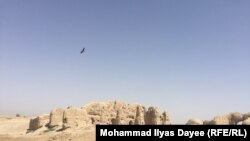LASHKAR GAH, Afghanistan -- Helmand is one of the most active battlefields in Afghanistan.
News reports from this southern province are mostly about Taliban suicide attacks and ambushes against government soldiers and offices. Sometimes the killing of a large number of insurgent fighters or their leaders being targeted makes the headlines.
For decades, this vast region -- bordering Pakistan and located close to Iran -- has been the global epicenter of opium production.
But while Helmand’s residents and its government grapple with its current problems, its rich archeological heritage showcasing its status as a midway point between India and Iran is rapidly declining.
Locals now fear that without a robust government strategy and international assistance insecurity, illegal excavations, and pillaging will lead to the complete destruction of many archeological sites spanning at least three millennia.
Helmand’s crown jewel, a once-massive mud-built fort locally called Qala-e Bost, is slowly being washed into the muddy waters of the nearby confluence of the Helmand and Arghandab rivers. The fort’s prized 11th-century arch, which still appears on the 100 afghani bank note, speaks volumes on the inadequate government and international support and clumsy efforts at preservation.
“The government is mainly preoccupied with fighting [the insurgents] and reconstruction and rehabilitation, to a limited extent,” said journalist Mujtaba Mohammadi. “Unfortunately, the authorities have done little to preserve Helmand’s rich cultural heritage.”
Mohammadi, who is writing a book on Helmand’s history and archeology, said some civilians displaced by fighting are squatting in many sites.
“More damaging are the illegal excavations [by treasure hunters]. Sometimes it is difficult to believe the amount of damage and destruction such activities cause,” he said. “It is very disheartening to see that the government is not paying any attention.”
Kabul has been pressing UNESCO to help preserve Qala-e Bost.
But a few years ago Kabul demolished a centuries-old fort and prison to build police barracks just a few kilometers away from the site in the provincial capital, Lashkar Gah.
Government bureaucrat Ali Shah Mazlumyar is tasked with preserving the region’s heritage as the regional representative of the Afghan Culture and Information Ministry.
With little or no resources, his only job seems to be observing the slow-motion destruction of archeological monuments.
“Helmand River is gradually eating into Qala-e Bost,” he noted. “More importantly, everything that is wrong here during the past 40 years of war is contributing to the destruction of our national heritage.”
Still, all is not lost for Helmand. Sharifullah Dost, a local writer and researcher, said that a little investment into Helmand’s archeological sites could attract domestic and international tourists.
He said he wants Kabul to approach UNESCO with a robust plan to preserve and promote Helmand’s heritage.
“When we claim to be a 5,000-year old nation, we must preserve our heritage to back such claims,” he said.
Abubakar Siddique wrote this story based on Mohammad Ilyas Dayee's reporting from Lashkar Gah, Helmand.






